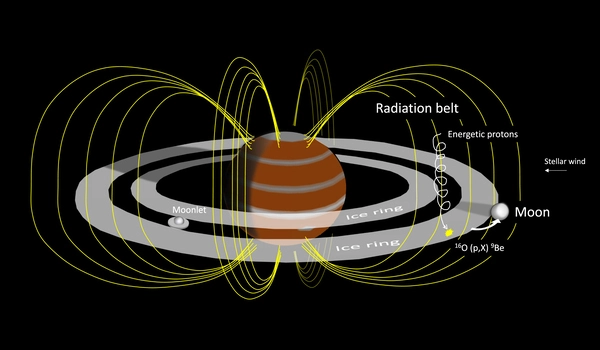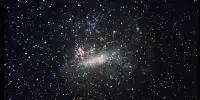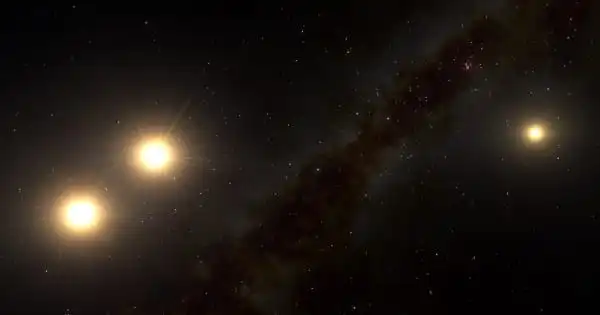Only two of the more than 5300 known exoplanets have been found to have moons in orbit around them. For the first time, researchers discovered evidence of such moons in observations of the planets Kepler-1625b and Kepler-1708b using the Kepler and Hubble space telescopes.
A new study casts doubt on these previous assertions. Scientists from the Max Planck Institute for Solar System Research (MPS) and the Sonnenberg Observatory in Germany report today in the journal Nature Astronomy that “planet-only” interpretations of the observations are more conclusive. The researchers used their newly developed computer algorithm Pandora, which facilitates and accelerates the search for exomoons, for their analysis. They also investigated what kind of exomoons can be found in principle in modern space-based astronomical observations. Their answer is quite shocking.
A planet being orbited by one or more moons is more the rule than the exception in our Solar System: aside from Mercury and Venus, all other planets have such companions; in the case of the gas giant Saturn, researchers have discovered 140 natural satellites to date.
As a result, scientists believe that moons may exist on planets in distant star systems. However, such exomoons have only been observed in two cases: Kepler-1625b and Kepler-1708b. This low yield comes as no surprise. After all, distant satellites are naturally much smaller than their home worlds – and thus much more difficult to locate. And combing through the observational data of thousands of exoplanets for evidence of moons is extremely time-consuming.
Exomoons are so far away that we cannot see them directly, even with the most powerful modern telescopes. Instead, telescopes record the fluctuations in brightness of distant stars, the time series of which is called a light curve.
Dr. René Heller
The authors of the new study rely on a search algorithm they developed and optimized themselves for the search for exomoons to make the search easier and faster. They published their method last year, and the algorithm is open-source code that is available to all researchers. When applied to Kepler-1625b and Kepler-1708b observational data, the results were astounding. “We would have liked to confirm the discovery of exomoons around Kepler-1625b and Kepler-1708b,” says MPS scientist Dr. René Heller, the study’s first author. “But unfortunately, our analyses show otherwise,” he said.
Hide and seek of an exomoon
Kepler-1625b, a Jupiter-like planet, made headlines five years ago. Columbia University in New York reported strong evidence of a giant moon in its orbit, dwarfing all other moons in the Solar System. The researchers examined data from NASA’s Kepler space telescope, which observed over 100,000 stars and discovered over 2000 exoplanets during its first mission from 2009 to 2013. However, the exomoon candidate forced astronomers to play a cosmic version of hide-and-seek in the years that followed the 2018 discovery claim.
It first vanished after the Kepler data was cleaned of systematic noise. However, clues were discovered again in subsequent Hubble Space Telescope observations. And then last year, this extraordinary exomoon candidate got company: according to the New York researchers, another giant moon much larger than Earth orbits the Jupiter-sized planet Kepler-1708b.

The right match
“Exomoons are so far away that we cannot see them directly, even with the most powerful modern telescopes,” explains Dr. René Heller. Instead, telescopes record the fluctuations in brightness of distant stars, the time series of which is called a light curve. Researchers then look for signs of moons in these light curves. If an exoplanet passes in front of its star as seen from Earth, it dims the star by a tiny fraction. This event is called a transit, and it re-occurs regularly with the orbital period of the planet around the star.
An exomoon accompanying the planet would have a similar dimming effect. Its trace in the light curve, however, would not only be significantly weaker. Due to the movement of the moon and planet around their mutual center of gravity, this additional dimming in the light curve would follow a rather complicated pattern. And there are other effects to be considered, such as planet-moon eclipses, natural brightness variations of the star and other sources of noise generated during telescopic measurements.
To detect the moons, both the New York researchers and their German colleagues must first calculate many millions of “artificial” light curves for all conceivable sizes, mutual distances, and orbital orientations of possible planets and moons. An algorithm then compares the simulated light curves to the observed light curve and finds the best match. The researchers from Göttingen and Sonneberg used their open-source algorithm Pandora, which is optimized for the search for exomoons and can solve this task several orders of magnitude faster than previous algorithms.
No trace of moons
In the case of the planet Kepler-1708b, the German duo found that scenarios without a moon can explain the observational data just as accurately as those with a moon. “The probability of a moon orbiting Kepler-1708b is clearly lower than previously reported,” says Michael Hippke from the Sonneberg Observatory and co-author of the new study. “The data do not suggest the existence of an exomoon around Kepler-1708b,” Hippke continues.
There is much to suggest that Kepler-1625b is also devoid of a giant companion. Transits of this planet in front of its star have previously been observed with the Kepler and the Hubble telescopes. The German researchers now argue that the instantaneous brightness variation of the star across its disk, an effect known as stellar limb darkening, has a crucial impact on the proposed exomoon signal. The limb of the solar disk, for example, appears darker than the center.
However, depending on whether you look at Kepler-1625b’s home star through the Kepler or the Hubble telescope, the limb darkening effect looks different. This is due to the fact that Kepler and Hubble are sensitive to different wavelengths of light that they receive. The researchers from Göttingen and Sonneberg now argue that their modeling of this effect explains the data more conclusively than a massive exomoon.
Their new, in-depth analyses also show that exomoon search algorithms frequently produce false-positive results. They repeatedly “discover” a moon when it is actually just a planet transiting its host star. The rate of “false hits” is likely to be around 11% for a light curve like Kepler-1625b.
“The earlier exomoon claim by our colleagues from New York was the result of a search for moons around dozens of exoplanets,” says Heller. “According to our estimates, a false-positive finding is not at all surprising, but almost to be expected,” he adds.
Strange satellites
The researchers also used their algorithm to predict the types of actual exomoons that could be clearly detected by light curve space missions such as Kepler. Only particularly large moons orbiting their planet in a wide orbit are detectable using current technology, according to their analysis. They would all be oddballs in comparison to our Solar System’s familiar moons, at least twice the size of Ganymede, the largest moon in the Solar System, and thus almost as big as Earth. “The first exomoons that will be discovered in future observations, such as from the PLATO mission, will certainly be very unusual and therefore exciting to explore,” Heller said.
















